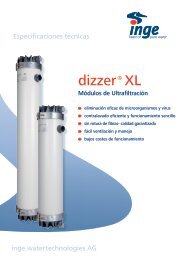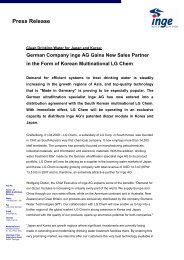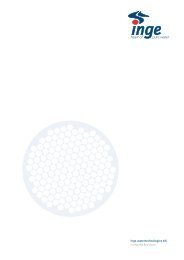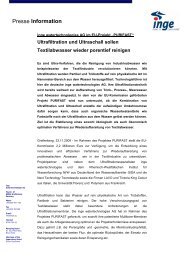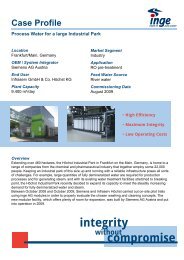Press Clipping Desalination (Filtration + Separation) - Inge AG
Press Clipping Desalination (Filtration + Separation) - Inge AG
Press Clipping Desalination (Filtration + Separation) - Inge AG
You also want an ePaper? Increase the reach of your titles
YUMPU automatically turns print PDFs into web optimized ePapers that Google loves.
<strong>Press</strong> <strong>Clipping</strong><br />
<strong>Desalination</strong> (<strong>Filtration</strong> + <strong>Separation</strong>)<br />
Volume 4 Issue 1<br />
<strong>Desalination</strong> pre-treatment: Efficient ultrafiltration for seawater<br />
Ralf Krüger from inge watertechnologies describes the growing popularity of<br />
ultrafiltration as pre-treatment in seawater desalination, and looks at its successful<br />
application at an Italian power plant that required an efficient and low-maintenance<br />
ultrafiltration solution.<br />
Ultrafiltration (UF), as pre-treatment technology, has become the preferred choice<br />
over reverse osmosis (RO) for problematic feed water such as surface or wastewater. UF<br />
can provide superior water quality compared with conventional treatment and delivers a<br />
continuously good filtrate quality independent of feedwater characteristics caused by, for<br />
instance, seasonal changes.<br />
In seawater applications UF is becoming more popular as well. This is due to the<br />
advancements in UF membrane technology and the scale of economies resulting from an<br />
increasing demand. Recent integral cost comparisons have shown that, when all cost<br />
components and impacts on the treatment steps downstrearn are taken into account, UF<br />
can compete with conventional pre-treatment technologies.<br />
One of the largest seawater desalination plants in Europe where UF is installed is located<br />
in Italy. This UF system features two innovative technologies in the field of membrane and<br />
module design which particularly address the need for highest operational safety and low<br />
operating cost. In the following article, the project background and the overall plant<br />
design will be described in detail, and operational data from the pilots and full-scale plant<br />
will be discussed.<br />
Focussing on environmental concerns<br />
The new water treatment plant (WTP) at the Torrevaldaliga Nord Power Station, some 50<br />
km north of Rome, is equipped with one of Europe's largest seawater UF systems. The plant<br />
is part of a complete revamp of the existing power plant station. The power plant owner,<br />
Italian's largest power and utility company ENEL, decided to replace four old oil-fired<br />
systems with three new coal-fired units with a total capacity of 660 MW. The plant<br />
concept, which focused on environmental, quality and innovative aspects, was rewarded<br />
with the Power-Gen Award for Technical Innovation 2005.<br />
The water treatment plant (WTP) was designed and built by Termomeccanica Ecologia<br />
based in La Spezia, Italy. A UF pilot plant was operated in November/December 2006 to<br />
verify and optimise the process parameters for the large scale plant. Construction work<br />
started beginning of 2007, and the WTP was commissioned in June 2008.<br />
Process design of the plant<br />
The feed water is seawater from an open intake in the Tyrrhenian Sea. To minimise the<br />
risk of oil being present in the feed water, the inlet point is located upstream of the<br />
prevailing current, at a distance to the harbour where oil and coal is unloaded for the<br />
power plant. Despite this, some oil and grease may be present in the feed water<br />
Page 1 of 6
so a dissolved air floatation unit (DAF) is installed. A welcome side effect of this is the<br />
overall improvement of the feed water quality it entails. The unit is designed for operation<br />
without any coagulant and operated in this way at present - however, ferric chloride can<br />
be used in principle.<br />
After the DAF, the water is purified by UF, and the UF filtrate is further treated by UV<br />
before it enters the two-pass RO plant. Some 5,600 m 3 /d RO permeate from the second<br />
pass is then treated by a mixed ion bed unit for use as boiler feed water, while another<br />
3,100 m3 /h RO permeate from the first pass is used for other technical services. A process<br />
overview is given in Figure 1.<br />
Benefits of UF modules<br />
The 372 dizzer® 5000 modules in the UF system are manufactured by ingle<br />
watertechnologies, a German company specialising in UF. The decision to install inge<br />
UF dizzer modules was due to a large extent on the additional operational safety along<br />
with the commercial benefits for the OEM and the enduser by implementing inge UF<br />
technology. The technology provided by the company includes two unique and innovative<br />
features designed to meet the specific challenges of the UF process - fibre integrity and<br />
Hydro dynamically optimised module design.<br />
Fibre integrity<br />
inge's dizzer modules are equipped with patented Multibore® UF hollow fibres operating in<br />
in-to-out mode. Multibore fibres are made from modified polyether sulphone with a high<br />
pH tolerance from 1 - 13 which allows efficient cleanings even under extreme conditions.<br />
The inner diameter of each individual capillary is 0.9 mm, which is larger than the common<br />
0.7 - 0.8 mm size, which increases the suspended particles limit. They have a larger<br />
diameter which can reduce the pressure drop and produce an even flow distribution along<br />
the fibre. This in turn helps distribute contaminants more evenly on the membrane surface<br />
and increases the backwash efficiency. The nominal pore size of the membranes is 0.020<br />
mm, which provides for an effective rejection of bacteria and viruses.<br />
The Multibore fibre combines seven capillaries into one fibre (see Figure 2) which results<br />
in an exceptionally high mechanical fibre strength. This can overcome the major problem<br />
facing UF hollow fibre technology, which is that there can be a rather large number of<br />
fibre breakages during operation. In municipal applications, fibre breaks have to be<br />
repaired immediately because of the bacteria and viruses that can enter the filtrate water.<br />
In industrial applications, the RO membranes will be fouled quicker and UF will not fulfil<br />
its capabilities. No no fibre breakages have been reported in more than six years of<br />
operation in hundreds of plants that use Multibore fibres. The benefits for the plant and<br />
the enduser are:<br />
• reduced maintenance and repair cost;<br />
• increased protection and performance of treatment steps downstream;<br />
• increased operating safety.<br />
Hydrodynamically optimised module design<br />
The internal design of the dizzer module has an annular gap instead of the conventional<br />
central core tube which is commonly used to collect the filtrate and for backwashing. This<br />
design improves backwash efficiency by providing an even flow distribution along the<br />
module cross section and ensuring that all fibres are backwashed with the same intensity.<br />
During backwash, the water flows from the annular gap towards the middle of the module.<br />
Page 2 of 6
On its way, the total backwash water flow is reduced because apart of the water enters<br />
the fibres for the actual backwash. Since the number of fibres also decreases towarcls the<br />
middle of the module, the backwash flux will remain at a similar level over the complete<br />
cross section of the module. This results in a more efficient cleaning and subsequently in<br />
higher permeability and less chemical consumption.<br />
The modules are mounted vertically for proper de-aeration to avoid water hammers. This<br />
arrangement makes it easier to access each module in case of maintenance.<br />
How the system works<br />
The UF system, designed for a total net output of 23,500 m 3 /d, consists of six trains, each<br />
equipped with 62 dizzer 5000 UF-modules. The modules are mounted in a vertical position<br />
with two rows of modules on either side of the central headers (Figure 3). The UF system<br />
was originally designed for five trains in operation plus one train on stand-by, but to avoid<br />
fouling in the stand-by train and to avoid increased wear from starting-up and shuttingdown<br />
it was decided to operate all six trains permanently at lower than design flux. The<br />
design flux can still be reachedif one train is shut-down for maintenance.<br />
Each train is equipped with one feed pump which is controlled by a flow transmitter in<br />
the feed line for individual flow control. Next to the feed pump is a self cleaning filter<br />
with a nominal filtration rate of 300 micron. The purpose of the filter is to protect the UF<br />
fibres from potentially harmful objects - such as swarfs. For the backwash three 50%<br />
pumps are installed, and both feed and backwash pumps are equipped with a variable<br />
frequency controlled motor.<br />
The UF process<br />
UF is operated in dead end mode with a design flux of 79 l/m 2 h with five trains in<br />
operation. This figure originates from the tender, where a maximum net flux of 60 I/m 2 h<br />
with all trains in operation was specified. During filtration mode, the feed water enters<br />
the modules from either from top or from bottom, and the feed directions are swapped<br />
after each backwash. With these alternating flow directions. The total fibre length can be<br />
used more efficiently when compared to a design in which the feed water enters the<br />
module continuously from the same end. In this way, build-up of an irreversible fouling<br />
layer on the membrane surface can be avoided or delayed.<br />
The operating philosophy of the UF system is to keep the transmembrane pressure (TMP),<br />
the main indicator of membrane fouling, at a continuously low level close to the initial 0.1<br />
to 0.2 bar of a new module. In this way, irreversible fouling and extensive CIP cleanings<br />
can be avoided to a large extent. To clean the membranes a backwash is carried out every<br />
45 minutes, and to control organic fouling, a chemical enhanced backwash using sodium<br />
hypochlorite with approximately 20 ppm residual chlorine and a soak time of 10 minutes<br />
takes place once a day. An additional chemical enhanced backwash using hydrochloric acid<br />
is carried out depending on membrane condition to remove any inorganic material carried<br />
over from the DAF.<br />
For additional operational safety the plant is equipped with connections for optional<br />
inline coagulation upstream of the UF to further reduce organic material and improve<br />
the backwash efficiency. Currently no inline coagulation is applied.<br />
Running (operating) a pilot plant<br />
A containerised pilot plant with one dizzer 5000 module was set up after the order award<br />
to demonstrate the functionality and operability of the modules and verify the operational<br />
Page 3 of 6
data proposed in inge's bid. The company also wanted to optimise its UF operating<br />
parameters for the large scale plant.<br />
The pilot tests started in November 2006 and took four weeks. The water used, taken<br />
from the collecting basin for the cooling tower make-up water was actually worse than<br />
that conceived in the design basis, because it came from near the coast and from the<br />
surface. Construction work in the harbour basin had also caused increased turbidity<br />
levels. Since the power plant was shut down, water in the collecting basin was not running<br />
and had developed a poor microbiological quality. Upstream of the UF system, a small<br />
flotation system had been installed to which no coagulants were added. Considering all the<br />
above, therefore, it could be said that the UF feed water quality was significantly worse<br />
than that conceived of in the design.<br />
During the first three days, the pilot plant operated at different fluxes of 60, 75, 90 and<br />
100 l/m 2 h to get a feeling for how the plant worked with the given feed water. After this<br />
time, the flux was set to 80 l/m 2 h for the rest of the pilot period. The pilot plant could be<br />
operated at a stable flux of 80 l/m 2 h. Regular backwashes were sufficient to fully recover<br />
the membrane permeability. The two daily chemical enhanced backwashes with sodium<br />
hypochlorite did not have any noticeable cleaning effect. However, in the long run the<br />
chlorine backwashes certainly enhance the cleaning efficiency and, therefore, are applied<br />
in the large scale plant as well. Only evaluation over a long term period will help to<br />
optimise plant operation.<br />
Throughout the pilot period all SDI15 measurements showed values of below 2.<br />
Installation of the full scale plant<br />
Commissioning of the WTP started in June 2008, while the UF system started up at end of<br />
July and went on stream at beginning in the first week of August 2008. Because of the<br />
ongoing construction work at the power plant, there had been a reduced demand for<br />
process water and so only half of the WTP is now in operation. Currently, three out of six<br />
UF lines are operating and delivering purified water to two out of four RO lines. To prevent<br />
biological growth in the three UF lines not in operation, the racks are filled with water<br />
containing 0.1 % sodium bi-sulphite which is being replaced on regular intervals.<br />
From start-up, the three operating UF lines have been run at design settings. Flux,<br />
filtration cycle time, backwashes and chemical enhanced backwashes are performed in<br />
accordance with the original design values.<br />
The graphs in Figure 4 showing the main operating parameters of UF line A since start-up<br />
are representative for the other two operating UF lines as well. The system has been<br />
continuously operated at a flux of 79 1/m 2 h with the exception of a short period where the<br />
capacity had to be reduced due to maintenance at the power plant. The transmembrane<br />
pressure stayed very stable at around 0.3 bar in spite of reduced water temperatures in<br />
the winter months - probably because of reduced biological activity causing less fouling.<br />
The normalised permeability has been very stable at around 250 l/m 2 hbar recently rising<br />
up to 360 l/m 2 h, with recovery higher than 93%.<br />
Above operating parameters are particularly interesting against the background of an<br />
average SDI 5 value of around 15 in the feed water which is beyond the design parameters.<br />
On the other hand, the filtrate water shows a continuously good water quality with an<br />
SDI15 below two almost all the time delivering excellent water quality to the reverse<br />
osmosis system. This very stable operation of the UF system could potentially lead to the<br />
extension of filtration cycles and reducing chemical consumption to reduce OPEX costs.<br />
Page 4 of 6
Since commissioning, the UF system has been operated under very stable conditions<br />
meeting all projected parameters in spite of challenging feed water quality.<br />
Contact<br />
Ralf Krüger<br />
inge watertechnologies<br />
Tel: +498192997721<br />
rkrueger@inge.ag<br />
www.inge.ag<br />
Acknowledgements<br />
The author gratefully acknowledges the support of Andrea Pagliari, Andrea Solito and<br />
Roberto Landi from Termomeccanica Ecologia in making available the information and data<br />
of the plant.<br />
Coarse<br />
Filter<br />
DAF Buffer<br />
Tank<br />
NaOCl Coagulant Coagulant<br />
Optional<br />
Antiscalant<br />
Figure 1: Simplified flow diagram of the Torrevaldaliga Nord Water treatment plant.<br />
Figure 2: Cross section of a Multibore ® fibre.<br />
Strainer UF Filtrate /<br />
Backwash Tank<br />
NaOCl Hcl<br />
UV RO 1st Pass Decarbonation RO 2nd Pass<br />
Mixed Bed IX<br />
Technical<br />
Services<br />
Sodium<br />
Bisulfite<br />
Page 5 of 6
Figure 3:The first ultrafiltration skid.<br />
Figure 4: Average data of full scale plant since start-up.<br />
Page 6 of 6




![[pdf] 345 kB - Inge AG](https://img.yumpu.com/21641051/1/184x260/pdf-345-kb-inge-ag.jpg?quality=85)
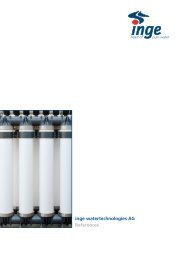
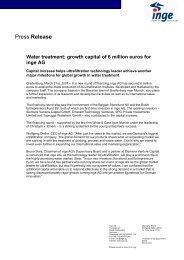
![[pdf] 432 kB - Inge AG](https://img.yumpu.com/6194776/1/184x260/pdf-432-kb-inge-ag.jpg?quality=85)
